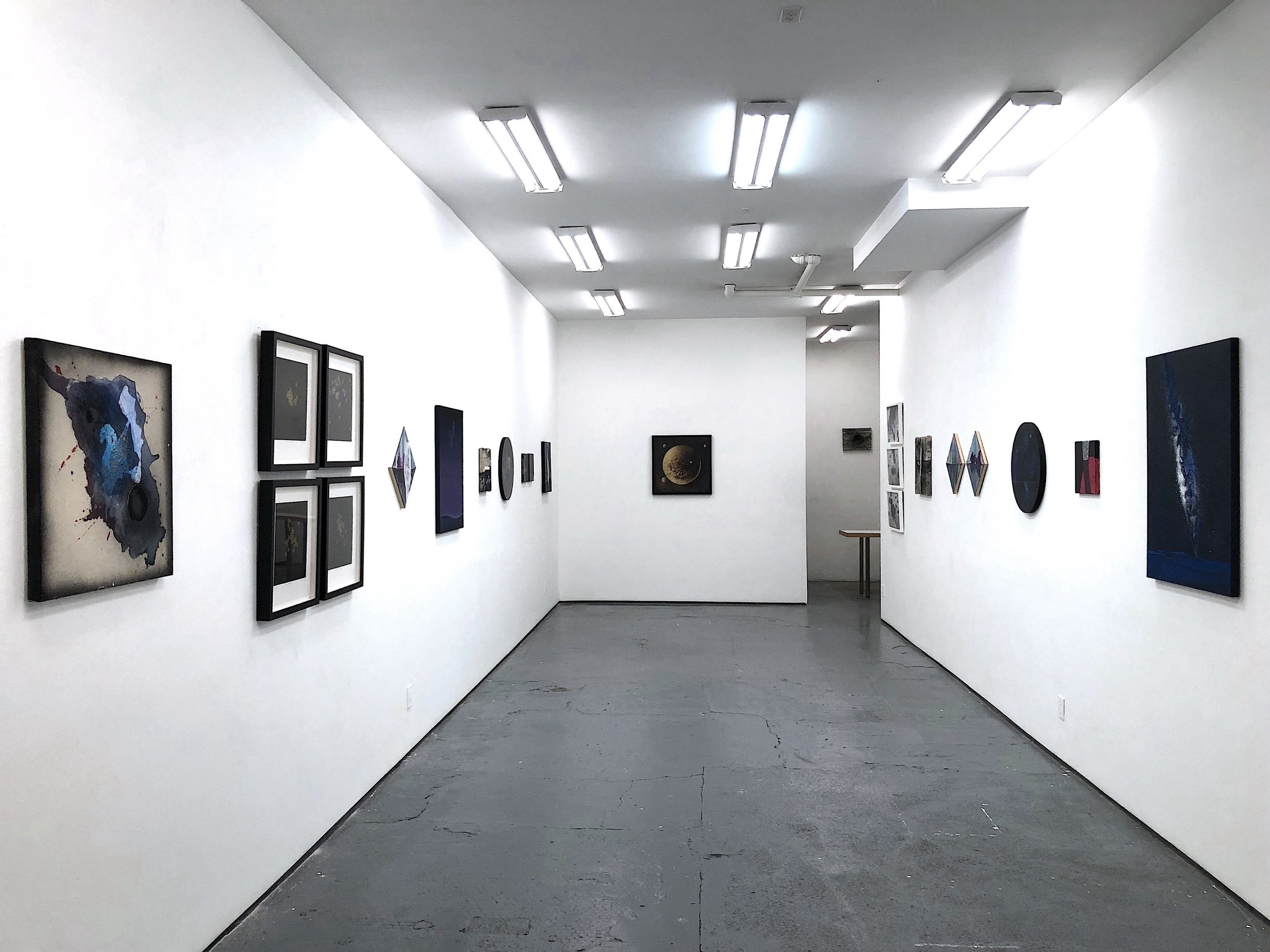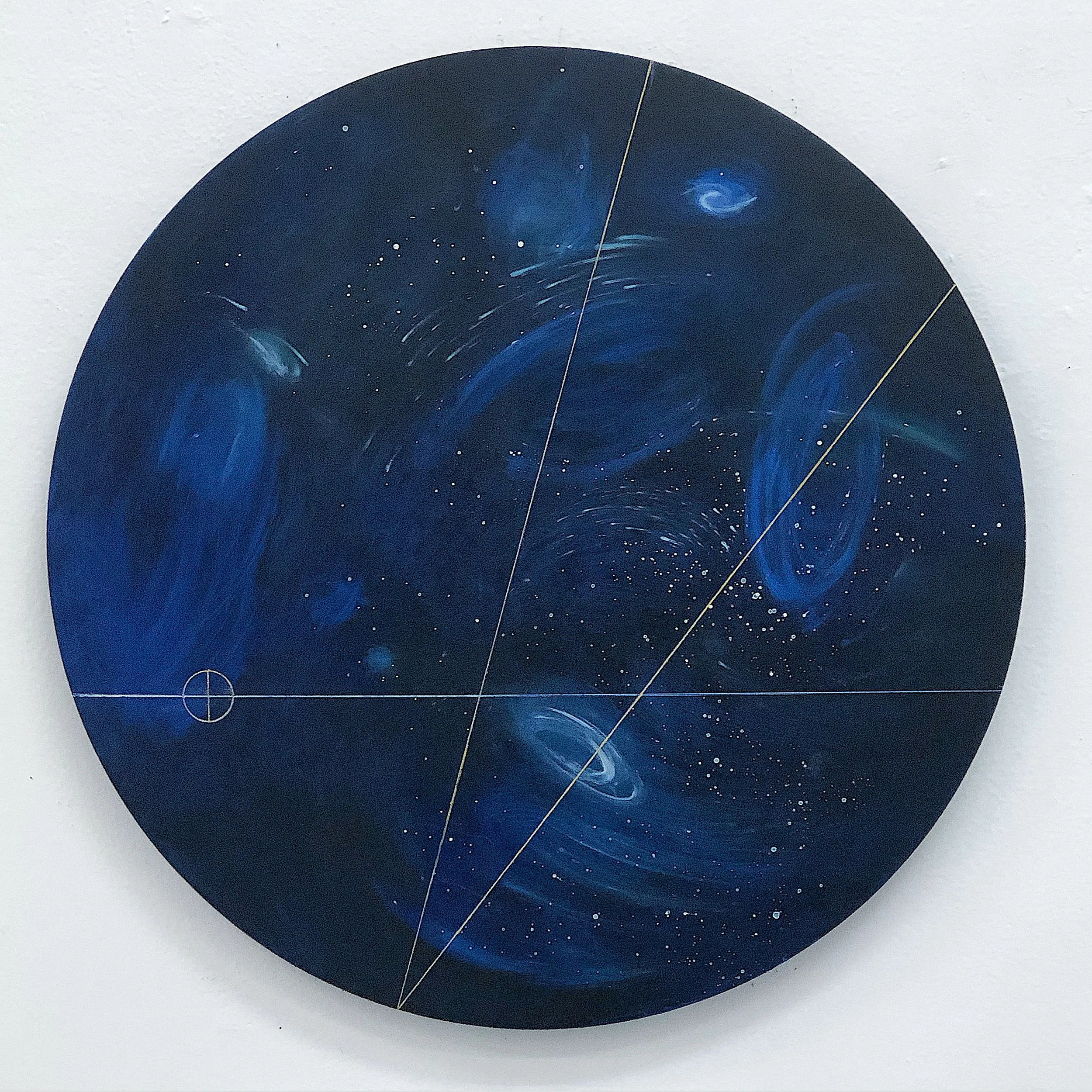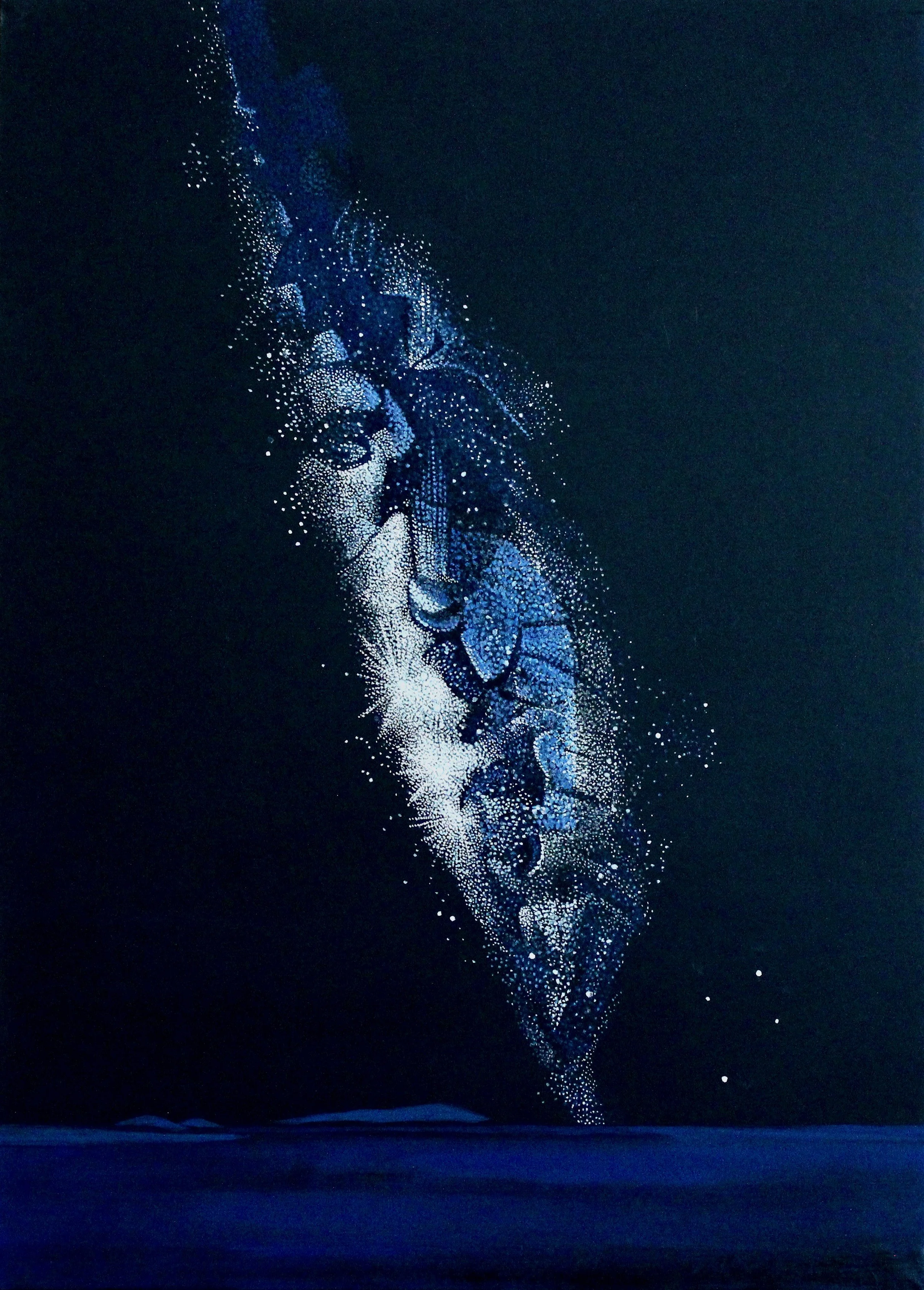Faces of the Deep
Installation view of the show under review. Image courtesy of the gallery.
When the first human looked up into the night sky, he or she saw what was imagined as infinity. And in that infinity, that human recognized the face of self. Even the first lines of Genesis indicate this:
In the beginning God created the heavens and the earth. The earth was without form and void, and darkness was upon the face of the deep, and the Spirit of God was moving over the face of the waters (Gen. 1:1-2 Revised Standard Version, italics mine).
Right there, from the beginning, one of the oldest stories on record — the creation — ushers us into the immensely profound, yet intimate, relationship we have with the universe and our own sense of identity: the face. When we look into the sky and imagine the universe at large, we are creating a metaphysical self-portrait.
The exhibition OUTER ORBIT/OUT OF ORBIT, curated by Priska Juschka at Lichtundfire, immediately arrests one's attention with the varying shapes of images displayed. Circles, diamonds, diptychs, triptychs and polyptychs become our celestial procession into the experience of, and beyond, the infinite.
Lydia Rubio, James WEBB #1, 2022. Oil on Panel, 20 in. diameter. Courtesy Lichtundfire, © Lydia Rubio
Lydia Rubio's James WEBB #1 features a circular wood panel which alerts us to an almost golden ratio, but on an astronomical scale. The diffuse dreamlike suggestions of galaxies share the composition with severe linearity, offering us an anchored trajectory through the cosmos. By way of our engagement with geometry, we find our way home, albeit intellectually.
Leslie Ford, Problem Solving #10 (left) & Problem Solving #13 (right), 2022. Acrylic, Casein, Ink on Panel, 12 x 12 in. each. Courtesy Lichtundfire, © Leslie Ford
In the diamond shapes of Leslie Ford's Problem Solving series, the problem of sky and earth, celestial and terrestrial is addressed. Ford transcends our expectations of the square painting and offers us not one central horizon, but four vanishing points. By altering the placement of the square to a diamond, the vanishing points — the corners — become a statement in and of themselves. The vanishing points transcend dimensions, omnidirectionally, suggesting infinite solutions. Problem solved.
Augustus Goertz, Leda and the Swan, 2018. Mixed media on Canvas, 24 x 24 in. Courtesy Lichtundfire, © Augustus Goertz
Augustus Goertz's Leda and the Swan references Michelangelo's lost painting of the same name. We are witnessing Goertz's personal memory of a lost masterpiece. The form of Leda’s floating body could be re-imagined as a form of celestial gas, a nebula. And in the lower right-hand side of this nebula is not a black hole, but a collapsed star — what was once illuminating recedes into its opposite, a retirement into blackness. The dead star, symbolically, is the lost painting, forever rendered as a memory in reproductions. Yet here, it lives.
Nancy Macko, From The First Ten Prime Numbers, Suite II Prime, 2004. Seventh, Eight, Ninth, Tenth Prime. Lithography, aquatint, and metallic powdered pigment on archival paper. Image: 12 x 12 in., 20 x 19 in (framed), Edition 7/10. Courtesy Lichtundfire, © Nancy Macko
Nancy Macko's minimalist polyptych is a selection of four from a suite of ten works visualizing primes. The series presents to us the beauty of the integer. The "O" shape can be circular, cyclical, a boundless, limitless continuum spiraling into itself. Or, mathematically, it could be zero, which joins the negative numbers with the positive numbers. The fulcrum of quantitative human consciousness is elegantly represented here. Each picture arranges the number spectrum in a unique way: four new imagined integer realities are presented as a polyptych.
Jeremiah Chechik, Iroria 7X, 2022. Digital Print on Aluminum Brushed Gold, Image: 24 x 24 in., 25 3/4 x 25 3/4 in. (framed). Courtesy Lichtundfire, © Jeremiah Chechik
Jeremiah Chechik's Iroria 7X, a digital print on aluminum brushed gold, offers an AI-driven digital exploration into deep abstract texture. Could this be an inspired memory — in the form of a digitally imagined snapshot — of the apparent creation of the universe? Chechik is a filmmaker as well; in the tradition of George Melies he offers us a concise and cinematically graceful dovetailing of existence in abeyance — as it is about to unfurl into our reality.
Leah Oates, Dot #1-#3, Prospect Park, Water Fall, 2016. Digital C-Print, 21 1/4 x 14 1/2 in. each (framed), edition of 10. Courtesy Lichtundfire, © Leah Oates
Leah Oates’s Dot #1-3 is a triptych of digital prints of water drops scanned from 35mm film. At first glance the drops resemble atoms, neutrons, and electrons, which themselves seem to resemble the orbital behavior of planets and stars. These images resemble a microscopic realm of cells, or even molecules. However, if these images were reproduced as exact negatives, they would likely resemble stars floating in the black void.
Barbara Bachner, ARC #47 (left) and ARC #48 (right), 2022. Acrylic on Canvas 10 x 10 in. (each). Courtesy Lichtundfire, © Barbara Bachner
In Barbara Bachner’s ARC paintings, both pictures, in their respective ways, alert us to the erupting release of worlds, minds, or realms. We may be experiencing an overhead perspective of transitions — releases into other possibilities, other universes, or just other philosophies. The triangular shape which appears in each picture can be viewed as both a straight road disappearing into the vanishing point, or an expulsion of something that expands as it interacts with the void.
Hiroko Ohno, Galaxy, 2021. Mixed Media on indigo ganpi paper mounted on wood panel, 35 x 25 in. Courtesy Lichtundfire, © Hiroko Ohno
The subtle, monochromatic indication of a horizon in Hiroko Ohno’s Galaxy reveals not one, but many, galaxies rising in communion. The personification of dignity, and the process of self-awareness, is presented in action here. The universe itself is finding order, and upright balance, at the guiding hands of the artist herself. It is a rebirth of all things, alerting us to that fact as the shape of a fetus can also be discerned among the starfield. Pregnant within the Universe's structure is the shape of a mind's will: the shape of Hiroko Ohno's Galaxy.
Instead of contemplating our external features endowed by the physical demands of nature, we contemplate the shape and composition of our thoughts, our musings, our transcendence. And in presenting the works of the various artists featured in OUTER ORBIT/OUT OF ORBIT, we see their very imagination manifest as the limitless, yet intimate, autobiography of the mind.
Barbara Bachner, Jeremiah Chechik, Leslie Ford, Augustus Goertz, Nancy Macko, Leah Oates, Hiroko Ohno and Lydia Rubio.
Curated by Priska Juschka.
March 2 to April 1 2023
Lichtundfire
175 Rivington Street, New York, NY 10002












